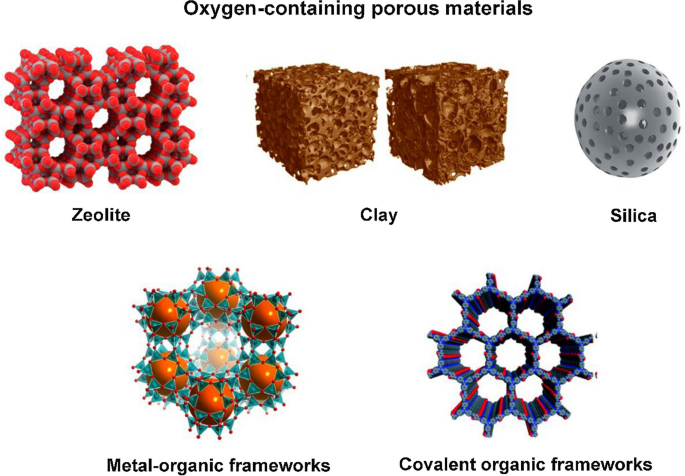Porous materials play a crucial role in various scientific, industrial, and environmental applications. These unique materials possess interconnected networks of pores, which enable them to exhibit fascinating properties such as high surface areas, selective adsorption, and efficient mass transport. In this article, we will delve into the world of porous materials, exploring their characteristics, classifications, synthesis methods, and diverse applications.
- Characteristics of Porous Materials: Porous materials are defined by their ability to contain void spaces or pores within their structures. These pores can range in size from nanometers to micrometers and can be categorized into three main types: micropores (less than 2 nm), mesopores (2-50 nm), and macropores (greater than 50 nm). The unique structural features of porous materials contribute to their exceptional properties, including high surface area, low density, and tunable pore size distribution.
- Classification of Porous Materials: Porous materials encompass a wide range of substances, including both organic and inorganic compounds. Here are some key classifications:
- a) Zeolites: Zeolites are crystalline, aluminosilicate minerals with a three-dimensional network of interconnected pores. These materials are commonly used in catalysis, gas separation, and ion exchange applications.
- b) Metal-Organic Frameworks (MOFs): MOFs consist of metal ions or clusters coordinated with organic ligands to form highly porous structures. MOFs offer great versatility due to their tunable properties, making them valuable in gas storage, drug delivery, and sensing applications.
- c) Porous Polymers: These are organic polymers with well-defined pores, typically synthesized using techniques like template synthesis or post-synthetic modification. Porous polymers find use in areas such as gas capture, membrane separation, and environmental remediation.
- d) Mesoporous Silica: Mesoporous silica materials have a network of ordered pores, typically in the range of 2-50 nm. They are widely employed in catalysis, drug delivery, and as fillers in various materials.
- e) Carbonaceous Materials: Carbon-based porous materials, such as activated carbons, carbon nanotubes, and graphene, possess exceptional porosity and high surface areas. They find applications in gas storage, water purification, energy storage, and more.
- Synthesis Methods: Porous materials can be synthesized using various techniques, depending on their composition and desired properties. Some commonly employed methods include:
- a) Sol-Gel Method: This technique involves the conversion of a precursor solution into a gel, followed by thermal or chemical treatment to form the porous structure.
- b) Templating: Templating methods utilize sacrificial templates, such as surfactants or polymer spheres, to create pores within the material. The template is subsequently removed, leaving behind the porous structure.
- c) Hydrothermal/Solvothermal Synthesis: In these methods, materials are synthesized under high-temperature and high-pressure conditions in a solvent. This process allows for the controlled growth of crystalline porous materials.
- d) Top-Down Approaches: Top-down methods involve the modification or etching of a solid material to create pores or to enhance an existing porous structure.
- Applications of Porous Materials: Porous materials find applications in diverse fields, showcasing their importance and versatility. Some notable applications include:
- a) Gas Separation and Storage: Porous materials with selective adsorption properties are utilized in gas separation processes, such as natural gas purification and carbon capture. They also serve as efficient storage media for gases like hydrogen.
- b) Catalysis: The high surface areas and well-defined pore structures of porous materials make them ideal catalyst supports. They facilitate efficient reactant diffusion and enhance catalytic activity in various
reactions, including chemical transformations, industrial processes, and environmental remediation.
- c) Adsorption and Filtration: Porous materials are widely employed for adsorption and filtration purposes. They can selectively capture and remove pollutants, contaminants, and heavy metals from water and air, contributing to improved water purification and air quality.
- d) Energy Storage: Porous materials play a significant role in energy storage technologies. They are used in supercapacitors and batteries, where their high surface area and porosity facilitate efficient ion transport and enhance energy storage capacity.
- e) Drug Delivery: Porous materials, particularly metal-organic frameworks (MOFs) and porous polymers, are explored for drug delivery applications. The pores can serve as reservoirs for drug molecules, allowing controlled release and targeted delivery to specific sites in the body.
- f) Sensing and Detection: The unique properties of porous materials make them promising candidates for sensing and detection applications. They can be functionalized to selectively adsorb and detect specific analytes, enabling the development of highly sensitive and selective sensors for various gases, chemicals, and biomolecules.
- g) Thermal Insulation: Porous materials with low thermal conductivity, such as aerogels, are utilized for thermal insulation in construction, transportation, and aerospace industries. Their porous structure minimizes heat transfer and improves energy efficiency.
- h) Environmental Applications: Porous materials are employed in environmental remediation processes, such as water and soil treatment. They can adsorb and remove organic pollutants, heavy metals, and toxic compounds, contributing to environmental cleanup efforts.
Conclusion: Porous materials represent a fascinating and rapidly evolving field of study, with immense potential in numerous scientific, industrial, and environmental applications. Their unique characteristics, synthesis methods, and classifications make them versatile and valuable materials for gas separation, catalysis, energy storage, drug delivery, sensing, insulation, and environmental remediation. Continued research and innovation in the field of porous materials are expected to unlock further possibilities and lead to advancements in a wide range of disciplines.
